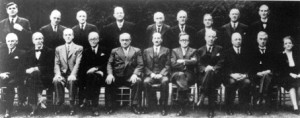Today in 1945 the British people awoke to the headlines that they had a socialist government. When parliament later reconvened, the newly elected Labour MPs stood to sing the ‘Red Flag’. To generations of us who have since come to regard Labour as very much part of the political establishment it is perhaps hard to appreciate the radical significance of this moment.
The general election of July 1945 was a landslide for the Labour Party with a majority of 146 seats – a shocking result to all those who had assumed that the stature of their leader Winston Churchill as wartime prime minister would assure a victory for the Conservatives. The spin-doctors of the wartime coalition National Government had mobilised the country’s war effort with the idea of a ‘people’s war’ to defeat fascism. And this proved to have unleashed radicalised hopes and dreams that could not be turned off like a tap with a return after the war to the poverty and uncertainty of the 1930s.
Failing to understand these aspirations, Churchill and the Conservatives massively misjudged the public mood. They provoked outrage when they attempted to characterise Labour and their mild bank-manager-like leader Clement Atlee as rabid Bolsheviks by running a scare campaign that claimed within a few years a ‘Gestapo’ would have to be introduced to enforce socialism.
The election actually ran for an unprecedented three weeks so that the votes of troops serving overseas could be counted, and this proved decisive: There had already been signs that many in the forces felt that they were fighting for rather more than ‘king and country’. In 1944 troops in the Middle East had convened a ‘forces parliament’ with strong support for Labour, Commonwealth and Communist delegates and a radical programme that included nationalisation of the banks. This mood was also replicated amongst troops stationed in the Far East where there were even strikes and mutinies. It was also seen across liberated Europe where resistance movements felt that they had not fought against fascism so as to just hand back power to the old order.
At home in Britain too there was a widespread sense that if the sacrifices of war were to count for anything then it was for a peacetime settlement based on social justice.
In 1942 it was actually a Liberal economist William Beveridge whose report articulated this mood. No socialist himself, Beveridge’s arguments for a health service, welfare provision, and state intervention in the economy, claimed that healthier and happier workers were productive workers and that planning was good for business. In doing so he primarily tried to appeal to ‘enlightened capitalists’ in the Conservative Party, but Labour took up his report as their vision for peacetime Britain. The Left wanted it implemented immediately and in 1943 there was a rebellion of backbench MPs demanding this, but right-wingers in the leadership like Ernest Bevin argued that victory must come first.
In fact when victory did come in 1945 Conservative support for Beveridge evaporated when they argued that the cost of reconstruction meant that the country could not afford his reforms. Memories returned of the ‘khaki election’ following the First World War when the ‘land fit for heroes’ promised by Lloyd George had never materialised and within ten years living standards had plummeted with a global depression.
Labour’s manifesto on the other hand stood by the Beveridge reforms, along with a programme of nationalisation of the heavy industries decimated by war – coal-mining; gas, oil and electricity; transport; iron and steel; and the Bank of England. But it was the idea of a health service and a massive programme of house-building that really mobilised working class support.
Although it was a programme far more radical than anything Labour has proposed either before or since, it was a very long way from socialism. In effect only 20% of the economy was taken into public ownership – but it was the 20% that required massive re-investment – largely to facilitate the profitability of the other 80%. Most importantly though this was reform from above; public ownership without the control, and barely the involvement, of the workers in those industries. Former owners were often installed on the boards of the newly nationalised industries. Even in the health service where the most tangible reforms were seen, opposition from the medical profession and the pharmaceutical industries produced a fudged settlement with a private sector piggybacking the public infrastructure and private businesses making profits from medicines. The architect of the NHS, and the most radical of the Labour ministers, Nye Bevan described this price as ‘stuffing their mouths with gold’.
Eventually it was precisely this fudged vision of socialism that was to lead Labour’s downfall. On the basis of trying to tweak the system into change rather than a full-on assault on the capitalist system, the Conservatives were actually proved right and the country could not afford Labour’s reforms. By 1948 Labour was bringing in an austerity programme and a return to wartime rationing. Although they managed to hang on until 1951 there was an inevitable backlash in the next election and there were Conservative governments for the next thirteen years.
From today’s perspective, a balance sheet on the 1945 government provides very mixed results: In terms of the daily lives of ordinary people, the establishment of the NHS made an enormous difference, as did the housing programme. On the other hand the nationalisation from above, whilst resulting in improved conditions in some industries like mining, failed to fulfil the hopes for a more democratically controlled economy. And whilst it could be said that in 1945 even the most rightwing of the Labour Party, in contrast to today, were ‘conviction’ rather than career politicians – ultimately an opportunity for a genuinely radical transformation of society with popular support was squandered.
[Written by journeyman]



3 Responses to 27th July 1945 – Labour’s Landslide Victory